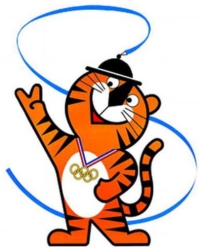
The Korean Sports Promotion Foundation (KPSO) maintains a Seoul Olympic Museum. It is located at Olympic-ro Songpa-gu, Seoul, Korea (05540).
The 1988 Summer Olympics (1988년 하계 올림픽), formally known as “the Games of the XXIV Olympiad” (제24회 올림픽경기대회) and commonly known in Korea as Seoul 1988 (서울 1988). The games were held from Sept. 17th to Oct. 2nd 1988. There were 159 nations represented by a total of 8,391 athletes (6,197 men and 2,194 women). There were 27,221 volunteers who assisted in the 237 separate events.
The idea for South Korea to place a bid for the 1988 Games emerged during the last days of the Park Chung-hee 박정희 (朴正熙) administration in the late 1970s. But before the making an offer to hold the games, Korea needed to prove the country’s ability to manage large events. In 1978, Korea successfully held the 42nd World Shooting Championships 제42회 세계사격선수권대회. It proved itself again by successfully staging the Miss Universe Pageant on July 8, 1980. The 1986 Asian Games are considered by many to be a dry run before the Olympics. Korea’s bid, to hold the games in Seoul, was submitted to the International Olympic Committee (IOC) on October 8, 1979, and Seoul was awarded the bid on September30, 1981.
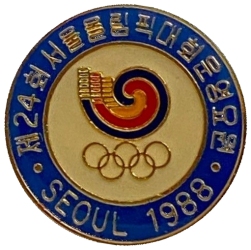
The issue of participation by the communist nations was inevitably sensitive. The Republic of Korea did not have established diplomatic relations with any communist countries at the time, and the Democratic People’s Republic of (North) Korea lobbied to prevent communist countries from participating. Nevertheless, the communist People’s Republic of China declared its intention to participate in July 1984 and the German Democratic Republic did the same in March 1985. The Soviet Union finally declared its participation, and Eastern Bloc countries such as Hungary and Poland also participated. Other communist countries such as Mongolia, Laos, and Vietnam, as well as African countries with a propensity for communism, took part. However, the Democratic People’s Republic of Korea did not participate. These were the last Olympic Games of the Cold War.1 For South Korea, the 1988 Olympics became the culmination of what was deemed the “Miracle on the Han River”.
In 1983, a mascot contest for the 1988 Seoul Olympics was held. Hyun Kim’s 김현 (金炫) work was selected with 12 votes out of a total of 14 votes. The official mascot for the 1988 Summer Olympic Games was Hodori which was selected in April 1984. It was a stylized tiger designed as an amicable Amur tiger, meant to portray the friendly and hospitable traditions of the Korean people. The tiger appears frequently in Korean popular art and legends, with a positive image, often associated with humor, bravery, and nobility. The name Hodori 호돌이 was chosen from 2,295 suggestions sent in by the public. The name is a compound of Ho 호, the Sino-Korean bound morpheme for “tiger” (as in Horangi 호랑이 the traditional word for “tiger”), and Dori 돌이, a diminutive for “boys”. There is also a female version of the mascot named Hosuni 호순이 (虎順伊). “Suni” is the Korean diminutive for “girl”.2 The Kellogg’s Co. of Battle Creek, Michigan said that Hodori too closely resembled Tony the Tiger and threatened the Seoul Olympic Organizing Committee (SLOOC) with a lawsuit for copyright infringement. SLOOC officials said that they were immune because South Korea, at the time, wasn’t a member of the Geneva Copyright Convention. Eventually, the two sides reach a compromise.3 The tiger reappeared for the PyeongChang 2018 Winter Olympic Games as Soohorang (수호랑), a white tiger and is often pictured with Bandabi (반다비) the official mascot of the 2018 Winter Paralympics. Both events were held in Pyeongchang, Gangwon, South Korea. Both creatures figure prominently in the Tangun (단군; 檀君) or Tangun Wanggeom (단군왕검; 檀君王儉) myth, in which the Korea people were created. Their Adam and Eve story, if you will. The tiger is also the logo for the Korean Football Association (KFA).
The 1988 Olympic Emblem
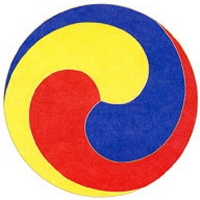
The symbol has been used extensively in Korean history.(Centripetal)
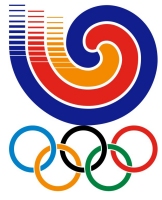
(Centrifugal)
The design for the logo for Seoul 88 was the result of a competition. However, rather than pre-selecting several designers to contribute proposals, it was open to all. The competition was advertised across the country through print media and radio, and to the international expatriate community by way of South Korean embassies.
The competition was initiated in 1982 by the Organizing Committee of the 1988 Seoul Games, the SLOOC. As was accepted at the time, only the winners would receive compensation. For first place, the prize was ₩3 m, with second and third place receiving ₩1 m each. The designers whose work was not selected went home empty-handed. When the competition closed in December 1982, there were a total of 924 submissions.
The emblem for the 1988 Seoul Olympics, was a modified Samtaeguk 삼태극 (三太極) pattern. The Samtaeguk is a traditional Korean pattern and visual image which represents Korea. This pattern is widely used as decoration on fans, gates of Korean-style homes, artifacts and folk crafts. The Olympic emblem features patterns in two forms, centripetal and centrifugal. The centripetal motion represented the people of the world coming together in Korea, thus symbolizing worldwide harmony, while the centrifugal motion represented a march outward, searching for man’s lasting happiness and prosperity. In 1983, Yang Sung-Chun 양승춘 (梁承椿, 1940 – 2017) produced the official emblem for the 1988 Summer Olympics.
At the same time, it is reminiscent of the Korean flag, the Taeguk Ki 태극기, (太極旗). The oldest Taeguk pattern on the Korean peninsula can be seen in tomb relics from the 7th century. A recently excavated Taeguk pattern was found which dates to around 618 CE. This is 400 years earlier than a similar pattern of the Chinese Song 宋 Dynasty (960–1279). Judging from this, the Taeguk pattern is possibly a unique Korean pattern that existed before, rather than being rooted in the Chinese Taeguk. Many similar patterns can be found in the Three Kingdoms Period of Korean history.4 For centuries, the Taeguk pattern has been central to Korean folk beliefs.
The 1988 Olympic Medals

In October 1986, the Seoul Olympic Organizing Committee (SLOOC) commissioned the Korea Security Printing and Minting Corporation to manufacture the medals. The corporation submitted the draft designs to the SLOOC for deliberation by its advisory committee, and the final designs of the medals for winners and participants were announced publicly in June 1987, after being endorsed by the IOC Executive Committee. On the obverse, the traditional goddess of victory, holding a palm in her left hand and a winner’s crown in her right. This design had been used since the 1928 Games in Amsterdam, and was created by Florentine artist Giuseppe Cassioli and chosen after a competition organized by the International Olympic Committee in 1921. For these Games, the figure of victory is accompanied by the specific inscription: “XXIV Olympiad Seoul 1988”. Yang Sung-Chun 양승춘 (梁承椿, 1940 – 2017) adjusted the obverse design with the inclusion of the script and was responsible for the reverse design.
On the reverse, a soaring dove, the symbol of peace, is shown holding a laurel branch in its mouth. Above this is the Seoul Olympic Emblem.
A total of 525 gold, 515 silver and 550 bronze medals were manufactured for the Seoul Olympic Games. All three Olympic medals have a 60 mm diameter x 5 mm thickness. There are sources which state that they have a 61 mm dia. The compositions for the three medals are: 1st Place is 92.5% Gold gilt with more than 5g of gold, 2nd Place is silver on Bronze, and 3rd Place is a Bronze, Zinc, and Copper alloy. The medals weigh: Gold 146 grams, Silver 140 grams, and Bronze 129 grams. They were manufactured by the Korea Security Printing and Minting Corporation (KOMSCO) 한국조폐공사 (韓國造幣公社).
The collector market is flooded with reproductions of these medals, not all of which are correctly sized.
The 1988 Olympic Participation Medals
There were two participation medals issued for the Seoul 1988 Summer Olympics, a round one given to athletes and a second octagonal one for Officials and Judges.
The Athlete’s Participation medal is round, composed of Bronze, has a 60 mm dia., 6 mm thick and weighs 115 gm. It was designed by Kim Kwang-hyun 김광현. The front depicts Namdaemun, the Great South Gate originally in the fortress walls of Seoul. Behind it are mountains, clouds, cranes, and the sun. The reverse bears the Seoul Games emblem and reads “XXIV Olympiad, Seoul 1988.” Complete with its original purple velvet case.
Often called the Press Participation Medal, but it was actually issued for the Officials and Judges’ who participated in the Seoul 1988 Summer Olympics. It is octagonal, bronze, measures 66 mm x 66 mm and weighs 155 gm. The obverse features a Korean archer on horseback, with the Olympic rings below, inscribed, “XXIVth Olympiad”, “Seoul 1988”. The reverse depicts the Seoul Olympic Stadium and features raised facsimile signatures of Juan Antonio Samaranch, president of the IOC, and Park Seh-jik 박세직 (朴世直, 1933 – 2009), president of the Seoul Olympic Organizing Committee, with the dates of the games below, “1988.9.17-10.2.”
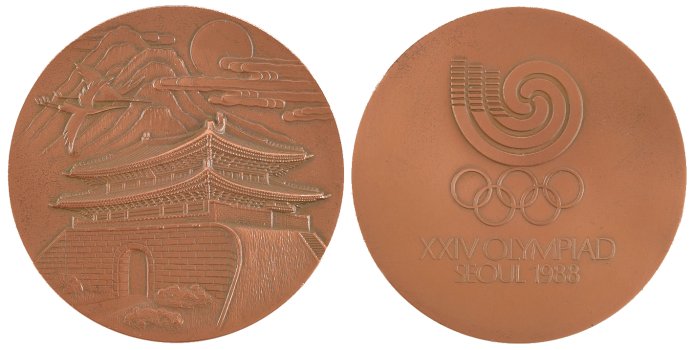
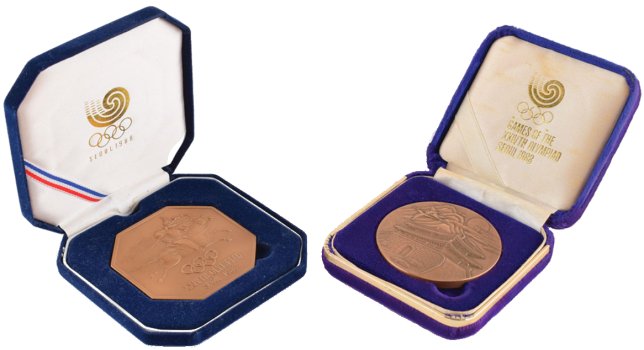
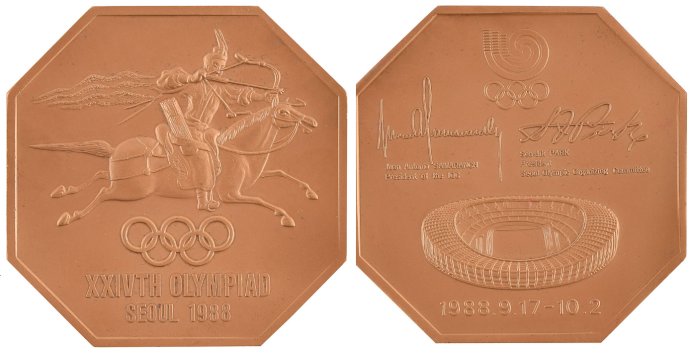
This medal came in both an English and a Korean language version.
The 1988 Olympic Service Medals
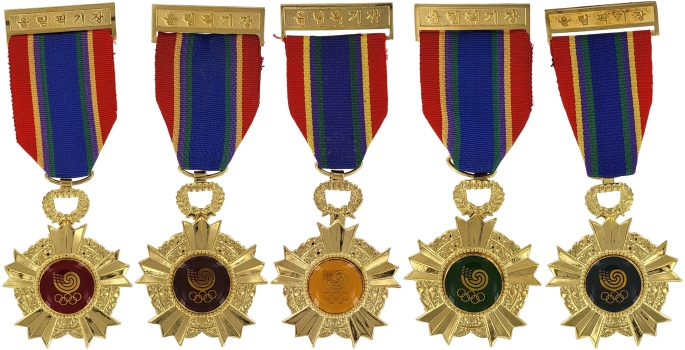
The Seoul Olympic Organizing Committee started recruiting volunteers for the Olympic Games in May 1986. About 120,000 people applied, and after selection competitions, 27,000 volunteers were chosen. This makes the volunteers approx. 54% of the total workforce of 50,200 or so.
On July 4, 1988, the Korean government issued Presidential Decree #12485, entitled “Olympic Medal Law” 올림픽기장령.5 This decree created the Olympic Service Medals. The decree uses the term Ki Jang 기장 (記章) which denotes the lowest level of medals produced by the Korean government. Its purpose was to award medals to those who “…devotedly served for the successful hosting of the 1988 Seoul Olympic Games.”.
The Presidential Decree authorized the use of 5 Service Medals:
- The “Games Medal” 대회장, which has a Red central disk, was awarded to those who directly participated in the preparation and operation of the games.
- The “Participation Medal” 참여장, which has a Dark Red (almost brown) central disk, was awarded to individuals who indirectly participated in the preparation and operation of the Games.
- The “Cultural Medal” 문화장, which has a Yellow central disk, was awarded to those who were involved in cultural and artistic events.
- The “Security Medal” 경비장, which has a (Bright) Green central disk, was awarded to those who provided security and security services.
- The “Service Medal” 봉사장, which has a Dark Green central disk, was awarded to (unpaid) volunteers.
The medals were conferred by the “Minister of Sports” 체육부장관. In the 2015 legislation for these medals, the conferring ministry was changed to the “Minister of Sports, Culture, and Tourism” 문화체육관광부장관. It is unknown why they modified the law for an award that was no longer issued. The medal can only be worn by the person who received it. After that person dies, the bereaved family may keep the medal.
The medal, with ribbon bar, was housed in a dark blue, fitted, hard plastic case, within a white cardboard sleeve. An award document accompanied the medal.
At the top of the medal’s obverse is the inscription “올림픽기장” Olympic (Service) Medal. On the planchet, as well as the ribbon bar, is a colored disk which indicates what it was awarded for. (See the class descriptions above). Within this disk is the 1988 Seoul Olympic Emblem. At the top of the planchet reverse, there is the national emblem of Korea.6 Below this is a two line inscription. The top line is “24th Seoul Olympic Games” 제 24-회서울올림픽대회. The second line contains the name of one of the five different medals as listed above. The color of the disk on the front directly corresponds to the name on the reverse. The dimensions are: length 18.9 mm, width 12.3 mm, and a height 11.8 mm.
In 1985, the United Nations established and declared December 5th as World Volunteer Day to promote and spread the spirit of volunteering. On December 5, 1989, Korea held its first Volunteer Day celebration at the Seoul YMCA.
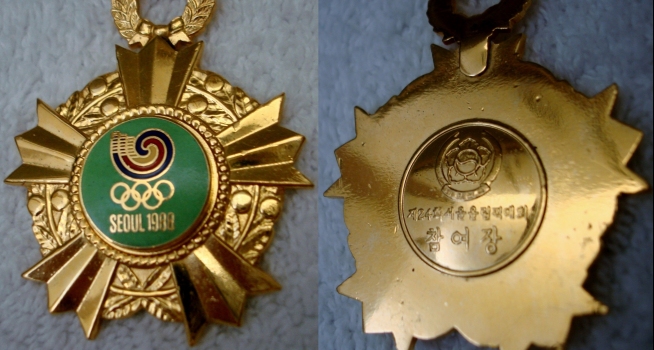
There is one rare anomaly regarding the 1988 Olympic Service Medals. The ribbon and top bar are identical to the other five Service Medals. The planchet, however, is different. The central disk is a bright-green color with the 1988 Seoul Olympic Emblem, but with the inscription “Seoul 1988”. The 5 standard Service Medals have an emblem which does not have “Seoul 1988”. The reverse inscription is “Participation Medal” 참여장. The standard “Participation Medal” has a Dark Red (almost Brown) central disk. The original picture source, claims that this medal was given to non-Korean volunteers, who resided in Korea (usually on work permit or military assignment to Korea). Of the 28,000 people who helped stage the 1988 Olympics, less than 200 were non-Korean. The original picture/information source was an EBAY lot and is no longer accessible. I have been unable to find any Korean legislation that authorizes this design, and I have been unable to find a second information source or picture.
Olympic Volunteer Enticement Medals
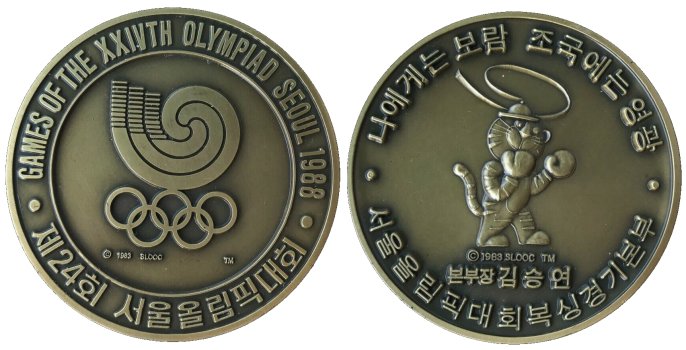
Many entrepreneurs were mobilized for the successful hosting of the Seoul Olympics. Right away, Hyundai Group Chairman Chung Ju-young was brought in to bid for the Seoul Olympics. When the bid for the Seoul Olympics was confirmed in September 1981, many conglomerates were pressed to add their corporation’s name and expertise to the Olympics. Samsung Chairman Lee Kun-hee served as the head of the wrestling team because he was active as a wrestler in high school. Dong-A Group Chairman Choi Won-seok was hired as the head of the Korea Table Tennis Association because he was a table tennis player in high school. Hanwha Corporation oversaw the boxing association according to the wishes of boxing enthusiast Kim Seung-yeon, it’s president.7
Roh Tae-woo 노태우 (盧泰愚 1932-2021), the chairman of the Seoul Olympic Organizing Committee, made a public request for volunteers. He said, “I ask you to directly participate in the operation of the 86 Asian Games and 88 Olympic Games under the belief that ‘It is rewarding for me, and glory for my country’.” The only restriction placed on applicants was that they had to be over the age of 16 to participate.8 “It is rewarding for me, and glory for my country”, became the catchphrase for the campaign to enlist volunteers.
For the medal at right: On the obverse, in the center, is the Seoul Olympic Emblem. In the arc at the top, the English inscription reads “Games of the 24th Olympiad Seoul 1988”, while on the bottom arc we have the Korean Inscription “제 24 회 서울 올림픽 대회”, 24th Seoul Olympic Games. On the reverse, we have the Korean Mascot, the Hodori with boxing gloves. Directly below this is the inscription “본부장 김승연”, Director Kim Seung-yeon 김승연 (金昇淵). In the rocker across the top is: “나에게는 보람 조국에는 영광” A reward for me, glory for my country. The bottom rocker has the inscription: “서울올림픽대회 복싱경기본부” Seoul Olympic Games Boxing Headquarters.
There are undoubtedly other enticement medals for other sports.

The Olympic Flame
The basic concept of an Olympic flame is derived from ancient Greek ceremonies. The flame of the modern Olympic movement was first introduced by architect Jan Wils, who designed the stadium for the 1928 Summer Olympics in Amsterdam. The Olympic torch relay has no ancient precedent and was introduced by Carl Diem at the 1936 Summer Olympics in Berlin, Germany. As an organizer, he wanted to glamorize the games with an ancient aura. The first Olympic torches were made by the Krupp Company, better known for providing weapons for the Russo-Japanese war and both world wars. In the Torch Relay tradition, a spark from the parent flame in Olympia, Greece ignites the torch that begins the Relay, ending in the host city in time for the opening ceremonies. The Olympic torch route of travel symbolizes human achievement.
It is not uncommon for the Olympic flame to be accidentally or deliberately extinguished during the torch relay (at the 1976 Summer Olympics held in Montreal, Quebec, Canada, the cauldron itself went gone out during the games). To guard against this, multiple copies of the flame are transported with the relay or maintained in backup locations. When a torch goes out, it is re-lit (or another torch is lit) from one of the backup sources. Thus, the flame, contained in the torches and Olympic cauldrons, all trace their common lineage back to the Olympia lighting ceremony in Greece. The current design of the torch has safeguards built into it. The Seoul Olympic Torch Relay involved over 1,800 torchbearers and the route was about 2,800 miles (4,506.16 km) long. Korea’s first Olympic gold medal winner, Sohn Kee-chung 손기정 (孫基禎), carried the Olympic torch into the stadium at the opening ceremony. He won gold in the marathon race at the 1936 Berlin Olympic Games. After being lit, the flame in the Olympic cauldron continues to burn until the closing ceremony, when it is put out, symbolizing the official end of the Games.

The torch for the 1988 Seoul Olympics has a with brown leather grip and maroon handle guard. The guard has “Games of The XXIVth Olympiad Seoul 1988” in raised gold lettering in both English and Korean. The bowl features black and gold engraving of two dragons, symbolizing the unity between the East and West. There is a red, blue, and yellow “Seoul 1988″ Olympic logo at the bottom portion of the bowl. It measures 20″ overall, with the bowl measuring 4” in diameter.
Seoul Mayor’s Participation Medal
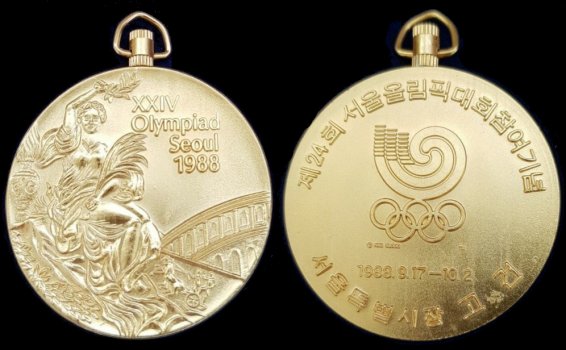
This medal presents a bit of a conundrum.
The obverse is nearly identical to the 1988 Gold Medals awarded to the winning athletes. The reverse has an inscription across the top of “Commemorating participation in the 24th Seoul Olympic Games” 제 24회 서울올림픽대회 참여기념. Below this is the Olympic Emblem with an inscription which gives the dates of the Seoul Olympics “1988.9.17–10.2”. Up to this point, everything is relatively straightforward. The bottom line contains the real issue. The inscription is “Mayor of Seoul – Goh Kun” 서울특별시장 고건. However, Goh Kun 고건 (高建) did not become the Mayor of Seoul until Dec. 5, 1988, over a month after the Olympics ended. Kim Yong-rae 김용래 (金庸來 1934-2009) was the mayor of Seoul from Dec. 30, 1987 until Dec. 5, 1988. Even if you assume that he was elected to office before or during the Olympics, it still would not entitle him to create a medal in this way.
I contacted a Korean that I know and asked about this conundrum. His response was essentially, and I paraphrase here: “The Seoul Olympic Games were not just an Olympic Game to South Korea in 1988. The South Korea government and her people thought that it was the biggest event and the greatest chance to do some marketing about South Korea to the world. He clearly remembers that time. After finishing the Olympics, the Korean government and the Seoul metropolitan government started to award volunteers. It lasted for at least a year after the Olympics. Some volunteers were invited to Cheongwadae 청와대 (靑瓦臺), the Blue House, the Korean presidential residence in April 1989. Yes, Goh Kun고건 was the Seoul Mayor after the Olympics, but this is a genuine medal which was given to Olympic volunteers after the games finished.”
The 1988 Olympic Lotteries
In 1899, the first modern Chinese lottery was issued in Shanghai. Cantonese merchants imported the Chinese lottery and broadly advertised lotteries in the newspaper in Seoul, Korea. In 1909, there were strong regulations against lottery business both in China and Korea. In Korea, however, the impetus to stop lotteries came from Korean nationalism as well as Japanese imperialist authority.
Lottery tickets 복권, 추첨권 have a long history in South Korea, with the first lottery going on sale in 1947. The proceeds were used to fund Korean athletes going to the 1948 Summer Olympics in London, England. There have been quite a few lotteries since then: 1949 saw the first Welfare Lottery, September 1969 the Housing Lottery was started by the Housing Lottery Bank, Sept. 1990 saw the Expo Lottery, the Lotto was started in Dec. 2002, and in July 2011, the Pension Lottery began. One of the ways that the city of Seoul was able to fund the 1988 Olympics was through the use of lotteries. There were 299 separate Olympic lotteries held to finance the event. Korean lottery tickets and lottery ticket albums occasionally come up for sale on EBAY. The “Lottery Tickets and Lottery Fund Act” (enacted and announced on January 29, 2004) created the Lottery Commission on April 1, 2004. It sees to the overall management and supervision of lotteries and improves the effectiveness and transparency of sales proceeds. In 2008, the commission was put under the Ministry of Strategy and Finance. Today there is an enormous variety of lottery games which Koreans can pick from.
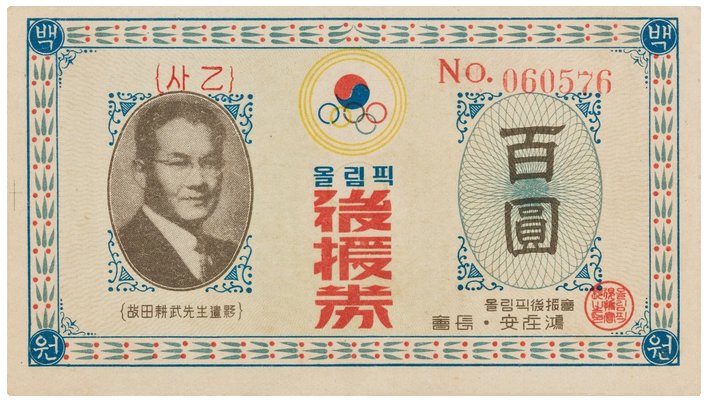
Size: Width 12.2 cm, Height 6.9 cm
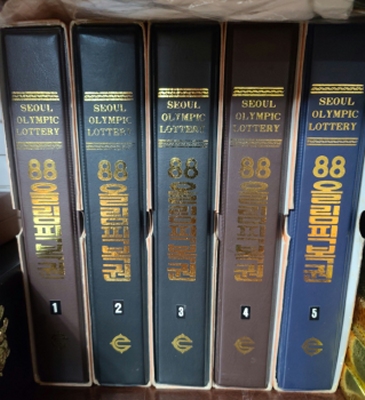
Other Collectible Items
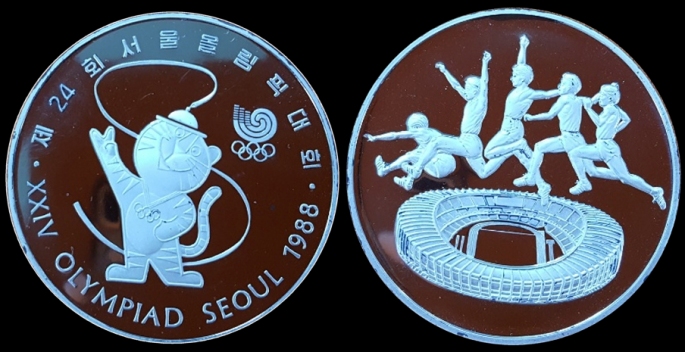
Very similar to the coinage, in silver proof, but without a denomination.
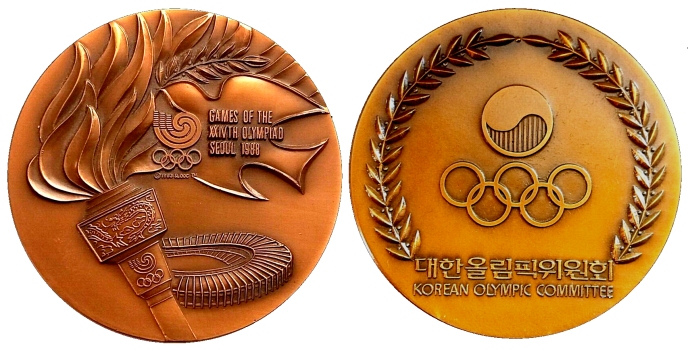
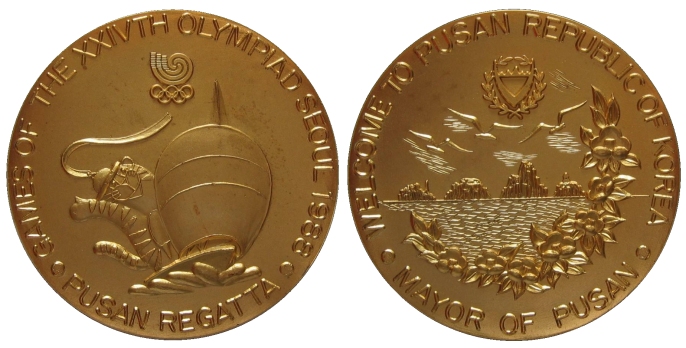
(Bronze, Dia. 60 mm, 5 mm Thick, 117.8 grams, unknown mintage)
Said to be a Participation Medal
I cannot confirm or deny
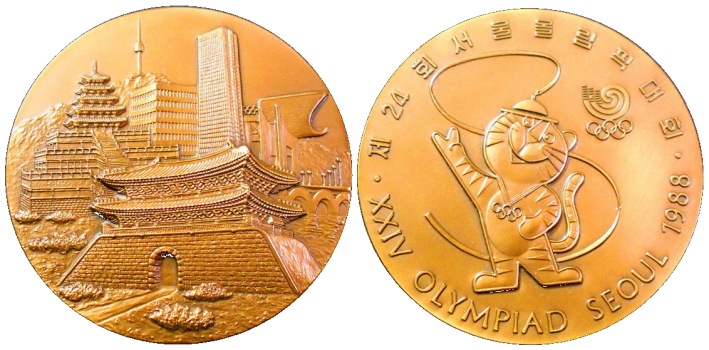
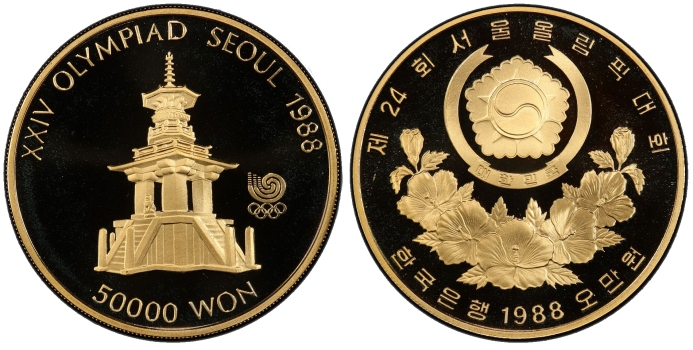
There were 32 different Korean coin designs issued for the Seoul Olympics, 28 of which could be bought in either Proof or Brilliant Uncirculated Proof. They could also be purchased as either individual coins or in sets.
Footnotes:
- The Soviet Union and East Germany both ceased to exist before the 1992 Olympic Games.
- According to French journalist Vincent Ricquart’s book, “The Games Within the Games”, Korean president Chun Doo-hwan 전두환 (全斗煥), selected the name because that was his nickname during his days at the Military Academy 육군사관학교 (陸軍士官學校).
- The cereal maker launched “Tony the Tiger” in 1952 and the smaller sized “Tony Jr.” was created a few years later.
- Samhan or the Three Kingdoms of Korea (삼국시대 三國時代) refers to the three kingdoms of Goguryeo (고구려, 高句麗), Baekje (백제, 百濟), and Silla (신라, 新羅). Goguryeo was later known as Goryeo (고려, 高麗), from which the modern name Korea is derived. The Three Kingdoms period is defined as being from 57 BC to 668 CE.
- Since the creation of the medals, the legal decree has been amended twice, by Presidential Decree #29950, dated July 2, 2019, and by Presidential Decree #26839, dated Dec, 31, 2015.
- The National Emblem of the Republic of Korea 대한민국의 국장 (大韓民國의 國章, lit. ’Republic of Korea national emblem’) consists of the taeguk symbol surrounded by five stylized petals of Korea’s National Flower, the Rose of Sharon (Hibiscus syriacus, 무궁화 無窮花, Mugunghwa). Below this is a ribbon bearing the inscription of the official name of the South Korea 대한민국. The emblem was adopted on Dec. 10, 1963. The flower and yin-yang symbols are generally considered by South Koreans to be symbolic of the “Korean race” (한민족, lit. “Han race”).
- Kim Seung-yeon 김승연 has sponsored various sports teams abroad. He was a sponsor of Major League Baseball’s San Francisco Giants. In soccer, he was an active sponsor with the Bolton Wanderers (England), the Hamburg SV (Germany), and the Juventus FC (Italy). He also served as president of the Korean Shooting Federation. His interests include boxing, and he served as president of the Korean Amateur Boxing Association from 1982 to 1988 and from 1990 to 1997. He owns the Korean baseball team, the Hanwha Eagles. Kim Seung-yeon 김승연 has been awarded, the Order of Sports Merit, White Horse (1982), the Order of Industrial Service Merit, Steel Tower (1983), the Sports Medal of Merit (1984), the Greek Order of the Phoenix (1986), the Order of Sports Merit, Blue Dragon Medal (1986), the Order of Industrial Service Merit, Gold Tower (1995), the Grand Order of Greece (1996), and a Medal of the Korean Red Cross (1998).
- Roh Tae-woo served as Chairman of the Seoul Olympic Organizing Committee from July 11, 1983 to May 7, 1986. He then served as President of the Seoul Olympic Organizing Committee from Aug. 12, 1984 to May 7, 1986. In both of the above positions, he was succeeded by Park Seh-jik, whose name appears on one style of Participation Medal. Roh Tae-woo was then elected and served as the 6th President of the Republic of Korea from Feb. 25, 1988 to Feb. 24, 1993.
